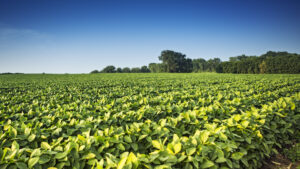The Ghanaian woman farmer simply laughed at any thought of switching her soy plot with that of her husband’s maize plot for the next planting season. Neither questioning nor considering the potential biological benefits commonly associated with rotational corn-soybean crop management systems, she rejected the concept. But why?
“Size, quality and location all add to the prestige associated with one’s plot, thus the price of rotating crops might actually be more ‘costly’ than the price of not rotating,” suggests Mary Read-Wahidi, a Mississippi State University postdoctoral research fellow. Not all costs can be measured in currency.
Access to land for female farmers in many developing lands is often controlled by the husband. However, men must first receive a land allocation from village leaders. Women generally end up with the smaller, more distant and less productive fields. The common practice of plural marriage in rural areas further complicates the land tenure system in much of sub-Saharan Africa, according to Kathleen Ragsdale, a Mississippi State University associate research professor.
The ramifications of gender and household dynamics of the statement, “rotate your soy plot next season with your husband’s maize plot,” might well overshadow any biological benefit that could be obtained from rotating corn and soybean fields. The English term “acre” is often found to have different meanings in various regions of Ghana. Consumer discussions about “soya” foods become fuzzy until one realizes that it depicts a specific prepared dish as opposed to being a broad term describing foods that contain soy. Might other production, use or storage practices, based on conventional thinking be similarly skewed?
Understanding Culture
Ragsdale and Read-Wahidi are joined by Jill Findeis, a University of Missouri professor of agricultural and applied economics. They comprise the socio-economic research team within The Feed the Future Soybean Innovation Lab, led by the University of Illinois. Their research probes sustainability, asset ownership and allocation to soybean, labor allocation, decision-making and soybean income control along gender lines.
Findeis’ team focuses on soybean value chain issues in Mozambique, while Ragsdale’s does so in Ghana. Initial findings in Mozambique indicate that only 17 percent of women, compared to 42 percent of men, are engaged in the full range of food crop decision-making. Findeis is implementing an intensive Soy Uptake and Network Survey to better understand the role of networks in soybean adoption, which includes family consumption and commercial production.
The Soybean Innovation Lab is designed to help improve: food security and household nutrition; sustainable agricultural productivity; and economic empowerment by providing farmers with income. The partnership between the applied social science team and agricultural bench science colleagues within the Soybean Innovation Lab has been effective. Early in her career, Ragsdale learned first-hand just how embedded women are within agricultural systems, especially in low-resource and developing countries —as farmers and mothers, producers and consumers.
Read-Wahidi provides a more holistic understanding of daily lives of male and female farmers. When shared with the non-sociocultural members of the research team, all become better positioned to improve the lives of the target population. “We get to talk to the farmers, spend time in the villages and understand people’s lives beyond their “crop yields” and “cost of production,” says Read-Wahidi.
Agricultural development conundrums, such as this in Ghana, are not isolated incidents. Their presence sends a clear message to seed industry representatives contemplating bold market development initiatives in uncharted waters. Soybean, primarily a commercial, non-native, non-staple, labor-intensive crop in sub-Saharan Africa, can serve as a good case study.
One must first determine if and how a given crop kind might fit within a culture and lifestyle. Then the focus can shift to determining the agronomic and environmental fit. In the end, biological sciences and good business practices likely will prevail; however, the impact on human life might be achieved more quickly when credence is given to the work of colleagues from the social science field and allowed to supplement contributions from biological and bench science.













